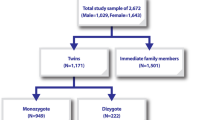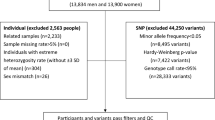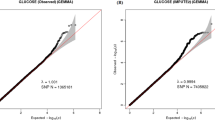Abstract
Purpose
Diabetes and dyslipidemia are among the most common chronic diseases with increasing global disease burdens, and they frequently occur together. The study aimed to investigate differences in the heritability of glycemic traits and serum lipid indicators and differences in overlapping genetic and environmental influences between them across age groups.
Methods
This study included 1189 twin pairs from the Chinese National Twin Registry and divided them into three groups: aged ≤ 40, 41–50, and > 50 years old. Univariate and bivariate structural equation models (SEMs) were conducted on glycemic indicators and serum lipid indicators, including blood glucose (GLU), glycated hemoglobin A1c (HbA1c), total cholesterol (TC), triglycerides (TG), low-density lipoprotein cholesterol (LDL-C) and high-density lipoprotein cholesterol (HDL-C), in the total sample and three age groups.
Results
All phenotypes showed moderate to high heritability (0.37–0.64). The heritability of HbA1c demonstrated a downward trend with age (HbA1c: 0.50–0.79), while others remained relatively stable (GLU: 0.55–0.62, TC: 0.58–0.66, TG: 0.50–0.63, LDL-C: 0.24–0.58, HDL-C: 0.31–0.57). The bivariate SEMs demonstrated that GLU and HbA1c were correlated with each serum lipid indicator (0.10–0.17), except HDL-C. Except for HbA1c and LDL-C, as well as HbA1c and HDL-C, differences in genetic correlations underlying glycemic traits and serum lipids between age groups were observed, with the youngest group showing a significantly higher genetic correlation than the oldest group.
Conclusion
Across the whole adulthood, genetic influences were consistently important for GLU, TC, TG, LDL-C and HDL-C, and age may affect the shared genetic influences between glycemic traits and serum lipids. Further studies are needed to elucidate the role of age in the interactions of genes related to glycemic traits and serum lipids.




Similar content being viewed by others
Data availability
The datasets analyzed during the current study are not publicly available but are available from the corresponding author on reasonable request.
References
Sun H, Saeedi P, Karuranga S, Pinkepank M, Ogurtsova K, Duncan BB et al (2022) IDF Diabetes Atlas: global, regional and country-level diabetes prevalence estimates for 2021 and projections for 2045. Diabetes Res Clin Pract 183:109119. https://doi.org/10.1016/j.diabres.2021.109119
Su LQ, Wang YD, Chi HY (2017) Effect of curcumin on glucose and lipid metabolism, FFAs and TNF-alpha in serum of type 2 diabetes mellitus rat models. Saudi J Biol Sci 24(8):1776–1780. https://doi.org/10.1016/j.sjbs.2017.11.011
Do R, Willer CJ, Schmidt EM, Sengupta S, Gao C, Peloso GM et al (2013) Common variants associated with plasma triglycerides and risk for coronary artery disease. Nat Genet 45(11):1345–1352. https://doi.org/10.1038/ng.2795
Mooradian AD (2009) Dyslipidemia in type 2 diabetes mellitus. Nat Clin Pract Endocrinol Metab 5(3):150–159. https://doi.org/10.1038/ncpendmet1066
Chen YC, Xu C, Zhang JG, Zeng CP, Wang XF, Zhou R et al (2018) Multivariate analysis of genomics data to identify potential pleiotropic genes for type 2 diabetes, obesity and dyslipidemia using Meta-CCA and gene-based approach. PLoS ONE 13(8):0e0201173. https://doi.org/10.1371/journal.pone.0201173
Fujihara K, Matsubayashi Y, Yamamoto M, Osawa T, Ishizawa M, Kaneko M et al (2017) Impact of body mass index and metabolic phenotypes on coronary artery disease according to glucose tolerance status. Diabetes Metab 43(6):543–546. https://doi.org/10.1016/j.diabet.2017.08.002
Athyros VG, Doumas M, Imprialos KP, Stavropoulos K, Georgianou E, Katsimardou A et al (2018) Diabetes and lipid metabolism. Hormones (Athens) 17(1):61–67. https://doi.org/10.1007/s42000-018-0014-8
Riserus U, Arnlov J, Berglund L (2007) Long-term predictors of insulin resistance: role of lifestyle and metabolic factors in middle-aged men. Diabetes Care 30(11):2928–2933. https://doi.org/10.2337/dc07-0360
De Silva NM, Freathy RM, Palmer TM, Donnelly LA, Luan J, Gaunt T et al (2011) Mendelian randomization studies do not support a role for raised circulating triglyceride levels influencing type 2 diabetes, glucose levels, or insulin resistance. Diabetes 60(3):1008–1018. https://doi.org/10.2337/db10-1317
DeFronzo RA, Bonadonna RC, Ferrannini E (1992) Pathogenesis of NIDDM. A balanced overview. Diabetes Care 15(3):318–368. https://doi.org/10.2337/diacare.15.3.318
Krauss RM (2008) What can the genome tell us about LDL cholesterol? Lancet 371(9611):450–452. https://doi.org/10.1016/S0140-6736(08)60213-5
Li JK, Ng MC, So WY, Chiu CK, Ozaki R, Tong PC et al (2006) Phenotypic and genetic clustering of diabetes and metabolic syndrome in Chinese families with type 2 diabetes mellitus. Diabetes Metab Res Rev 22(1):46–52. https://doi.org/10.1002/dmrr.577
Qi Q, Liang L, Doria A, Hu FB, Qi L (2012) Genetic predisposition to dyslipidemia and type 2 diabetes risk in two prospective cohorts. Diabetes 61(3):745–752. https://doi.org/10.2337/db11-1254
Kim YK, Hwang MY, Kim YJ, Moon S, Han S, Kim BJ (2016) Evaluation of pleiotropic effects among common genetic loci identified for cardio-metabolic traits in a Korean population. Cardiovasc Diabetol 15:20. https://doi.org/10.1186/s12933-016-0337-1
Li N, van der Sijde MR, LifeLines Cohort Study G, Bakker SJ, Dullaart RP, van der Harst P et al (2014) Pleiotropic effects of lipid genes on plasma glucose HbA1c and HOMA-IR levels. Diabetes 63(9):3149–3158. https://doi.org/10.2337/db13-1800
Feng L, Nian S, Tong Z, Zhu Y, Li Y, Zhang C et al (2020) Age-related trends in lipid levels: a large-scale cross-sectional study of the general Chinese population. BMJ Open 10(3):e034226. https://doi.org/10.1136/bmjopen-2019-034226
Chia CW, Egan JM, Ferrucci L (2018) Age-Related changes in glucose metabolism, hyperglycemia, and cardiovascular risk. Circ Res 123(7):886–904. https://doi.org/10.1161/CIRCRESAHA.118.312806
Gao W, Cao W, Lv J, Yu C, Wu T, Wang S et al (2019) The Chinese National Twin Registry: a “gold mine” for scientific research. J Intern Med 286(3):299–308. https://doi.org/10.1111/joim.12926
Wang B, Gao W, Yu C, Cao W, Lv J, Wang S et al (2015) Determination of zygosity in adult Chinese twins using the 450K methylation array versus questionnaire data. PLoS ONE 10(4):e0123992. https://doi.org/10.1371/journal.pone.0123992
Rijsdijk FV, Sham PC (2002) Analytic approaches to twin data using structural equation models. Brief Bioinform 3(2):119–133. https://doi.org/10.1093/bib/3.2.119
Akaike H (1987) Factor analysis and the AIC. Psychometrika 52(3):317–332. https://doi.org/10.1007/BF02294359
Wu Y, Zhang D, Pang Z, Jiang W, Wang S, Li S et al (2015) Multivariate modeling of body mass index, pulse pressure, systolic and diastolic blood pressure in Chinese twins. Twin Res Hum Genet 18(1):73–78. https://doi.org/10.1017/thg.2014.83
Alghamdi AS, Alqadi A, Jenkins RO, Haris PI (2021) The influence of gender and menopausal status on Hba1c variation in a big data study of a Saudi population. Curr Diabetes Rev 17(3):365–372. https://doi.org/10.2174/1573399816999200729143238
Murakata Y, Fujimaki T, Yamada Y (2015) Age-related changes in clinical parameters and their associations with common complex diseases. Biomed Rep 3(6):767–777. https://doi.org/10.3892/br.2015.505
Souren NY, Paulussen AD, Loos RJ, Gielen M, Beunen G, Fagard R et al (2007) Anthropometry, carbohydrate and lipid metabolism in the East Flanders Prospective Twin Survey: heritabilities. Diabetologia 50(10):2107–2116. https://doi.org/10.1007/s00125-007-0784-z
Luo BF, Du L, Li JX, Pan BY, Xu JM, Chen J et al (2010) Heritability of metabolic syndrome traits among healthy younger adults: a population based study in China. J Med Genet 47(6):415–420. https://doi.org/10.1136/jmg.2009.068932
Almgren P, Lehtovirta M, Isomaa B, Sarelin L, Taskinen MR, Lyssenko V et al (2011) Heritability and familiality of type 2 diabetes and related quantitative traits in the Botnia Study. Diabetologia 54(11):2811–2819. https://doi.org/10.1007/s00125-011-2267-5
Liu H, Wang W, Zhang C, Xu C, Duan H, Tian X et al (2018) Heritability and genome-wide association study of plasma cholesterol in Chinese adult twins. Front Endocrinol (Lausanne) 9:677. https://doi.org/10.3389/fendo.2018.00677
Pilia G, Chen WM, Scuteri A, Orru M, Albai G, Dei M et al (2006) Heritability of cardiovascular and personality traits in 6,148 Sardinians. PLoS Genet 2(8):e132. https://doi.org/10.1371/journal.pgen.0020132
Papakonstantinou E, Oikonomou C, Nychas G, Dimitriadis GD (2022) Effects of diet, lifestyle, chrononutrition and alternative dietary interventions on postprandial glycemia and insulin resistance. Nutrients 14(4):823. https://doi.org/10.3390/nu14040823
Zhang X, Imperatore G, Thomas W, Cheng YJ, Lobelo F, Norris K et al (2017) Effect of lifestyle interventions on glucose regulation among adults without impaired glucose tolerance or diabetes: a systematic review and meta-analysis. Diabetes Res Clin Pract 123:149–164. https://doi.org/10.1016/j.diabres.2016.11.020
Li S, Kyvik KO, Duan H, Zhang D, Pang Z, Hjelmborg J et al (2016) Longitudinal investigation into genetics in the conservation of metabolic phenotypes in Danish and Chinese twins. PLoS ONE 11(9):e0162805. https://doi.org/10.1371/journal.pone.0162805
Williams CJ, Wijesiri UW (1993) Lipid data from NHLBI veteran twins: interpreting genetic analyses when model assumptions fail. Genet Epidemiol 10(6):551–556. https://doi.org/10.1002/gepi.1370100637
Snieder H, van Doornen LJ, Boomsma DI (1999) Dissecting the genetic architecture of lipids, lipoproteins, and apolipoproteins: lessons from twin studies. Arterioscler Thromb Vasc Biol 19(12):2826–2834. https://doi.org/10.1161/01.atv.19.12.2826
Friedlander Y, Austin MA, Newman B, Edwards K, Mayer-Davis EI, King MC (1997) Heritability of longitudinal changes in coronary-heart-disease risk factors in women twins. Am J Hum Genet 60(6):1502–1512. https://doi.org/10.1086/515462
Zhang M, Zhou J, Liu Y, Sun X, Luo X, Han C et al (2018) Risk of type 2 diabetes mellitus associated with plasma lipid levels: the rural Chinese cohort study. Diabetes Res Clin Pract 135:150–157. https://doi.org/10.1016/j.diabres.2017.11.011
Sosenko JM, Breslow J, Miettinen OS, Gabbay KH (1982) Hyperglycemia and plasma lipid levels: covariations in insulin-dependent diabetes. Diabetes Care 5(1):40–43. https://doi.org/10.2337/diacare.5.1.40
Owei I, Umekwe N, Wan J, Dagogo-Jack S (2016) Plasma lipid levels predict dysglycemia in a biracial cohort of nondiabetic subjects: potential mechanisms. Exp Biol Med (Maywood) 241(17):1961–1967. https://doi.org/10.1177/1535370216659946
Zhang L, Qiao Q, Tuomilehto J, Hammar N, Janus ED, Soderberg S et al (2009) Blood lipid levels in relation to glucose status in seven populations of Asian origin without a prior history of diabetes: the DECODA study. Diabetes Metab Res Rev 25(6):549–557. https://doi.org/10.1002/dmrr.994
James DE, Stockli J, Birnbaum MJ (2021) The aetiology and molecular landscape of insulin resistance. Nat Rev Mol Cell Biol 22(11):751–771. https://doi.org/10.1038/s41580-021-00390-6
Kumar S, Kumari B, Kaushik A, Banerjee A, Mahto M, Bansal A (2022) Relation Between HbA1c and lipid profile among prediabetics, diabetics, and non-diabetics: a hospital-based cross-sectional analysis. Cureus 14(12):e32909. https://doi.org/10.7759/cureus.32909
Kong X, Zhang X, Xing X, Zhang B, Hong J, Yang W (2015) The association of Type 2 diabetes loci identified in genome-wide association studies with metabolic syndrome and its components in a chinese population with Type 2 Diabetes. PLoS ONE 10(11):e0143607. https://doi.org/10.1371/journal.pone.0143607
Downie CG, Dimos SF, Bien SA, Hu Y, Darst BF, Polfus LM et al (2022) Multi-ethnic GWAS and fine-mapping of glycaemic traits identify novel loci in the PAGE Study. Diabetologia 65(3):477–489. https://doi.org/10.1007/s00125-021-05635-9
Klarin D, Damrauer SM, Cho K, Sun YV, Teslovich TM, Honerlaw J et al (2018) Genetics of blood lipids among ~300,000 multi-ethnic participants of the Million Veteran Program. Nat Genet 50(11):1514–1523. https://doi.org/10.1038/s41588-018-0222-9
Stancakova A, Paananen J, Soininen P, Kangas AJ, Bonnycastle LL, Morken MA et al (2011) Effects of 34 risk loci for type 2 diabetes or hyperglycemia on lipoprotein subclasses and their composition in 6,580 nondiabetic Finnish men. Diabetes 60(5):1608–1616. https://doi.org/10.2337/db10-1655
Avery CL, He Q, North KE, Ambite JL, Boerwinkle E, Fornage M et al (2011) A phenomics-based strategy identifies loci on APOC1, BRAP, and PLCG1 associated with metabolic syndrome phenotype domains. PLoS Genet 7(10):e1002322. https://doi.org/10.1371/journal.pgen.1002322
Carty CL, Bhattacharjee S, Haessler J, Cheng I, Hindorff LA, Aroda V et al (2014) Analysis of metabolic syndrome components in >15 000 african americans identifies pleiotropic variants: results from the population architecture using genomics and epidemiology study. Circ Cardiovasc Genet 7(4):505–513. https://doi.org/10.1161/CIRCGENETICS.113.000386
Lin E, Kuo PH, Liu YL, Yang AC, Kao CF, Tsai SJ (2016) Association and interaction of APOA5, BUD13, CETP, LIPA and health-related behavior with metabolic syndrome in a Taiwanese population. Sci Rep 6:36830. https://doi.org/10.1038/srep36830
Klimentidis YC, Arora A, Newell M, Zhou J, Ordovas JM, Renquist BJ et al (2020) Phenotypic and genetic characterization of lower LDL cholesterol and increased Type 2 diabetes risk in the UK Biobank. Diabetes 69(10):2194–2205. https://doi.org/10.2337/db19-1134
Rung J, Cauchi S, Albrechtsen A, Shen L, Rocheleau G, Cavalcanti-Proenca C et al (2009) Genetic variant near IRS1 is associated with type 2 diabetes, insulin resistance and hyperinsulinemia. Nat Genet 41(10):1110–1115. https://doi.org/10.1038/ng.443
Kilpelainen TO, Zillikens MC, Stancakova A, Finucane FM, Ried JS, Langenberg C et al (2011) Genetic variation near IRS1 associates with reduced adiposity and an impaired metabolic profile. Nat Genet 43(8):753–760. https://doi.org/10.1038/ng.866
Iliadou A, Lichtenstein P, de Faire U, Pedersen NL (2001) Variation in genetic and environmental influences in serum lipid and apolipoprotein levels across the lifespan in Swedish male and female twins. Am J Med Genet 102(1):48–58. https://doi.org/10.1002/1096-8628(20010722)102:1%3c48::aid-ajmg1388%3e3.0.co;2-4
Acknowledgements
We thank all the participants and project staff who took part in the Chinese National Twin Registry for their contributions.
Funding
This study was funded by the National Natural Science Foundation of China (82073633, 81973126, 81573223), the Special Fund for Health Scientific Research in the Public Welfare (201502006, 201002007), and Peking University Outstanding Discipline Construction Project of Epidemiology and Biostatistics.
Author information
Authors and Affiliations
Contributions
WG conceived and designed the study; ZP, MY, HW, XW, and YL helped conduct the field study and collect the data; XH, WC, JL, CY, TH, DS, CL and YP contributed to interpreting the results and provided critical comments; LL designed and supervised the conduct of the whole study and obtained funding; and YW analyzed data and drafted the manuscript. All authors reviewed and approved the final version of the manuscript.
Corresponding authors
Ethics declarations
Conflict of interest
The authors declared no conflict of interest in this study.
Ethical approval
This study was performed in line with the principles of the Declaration of Helsinki. Ethics approval was accepted by the Biomedical Ethics Committee at Peking University, Beijing, China (IRB00001052-13022/14021).
Informed consent
Informed consent was obtained from all individual participants included in the study.
Additional information
Publisher's Note
Springer Nature remains neutral with regard to jurisdictional claims in published maps and institutional affiliations.
Supplementary Information
Below is the link to the electronic supplementary material.
Rights and permissions
Springer Nature or its licensor (e.g. a society or other partner) holds exclusive rights to this article under a publishing agreement with the author(s) or other rightsholder(s); author self-archiving of the accepted manuscript version of this article is solely governed by the terms of such publishing agreement and applicable law.
About this article
Cite this article
Wang, Y., Hong, X., Cao, W. et al. Age effect on the shared etiology of glycemic traits and serum lipids: evidence from a Chinese twin study. J Endocrinol Invest 47, 535–546 (2024). https://doi.org/10.1007/s40618-023-02164-7
Received:
Accepted:
Published:
Issue Date:
DOI: https://doi.org/10.1007/s40618-023-02164-7




